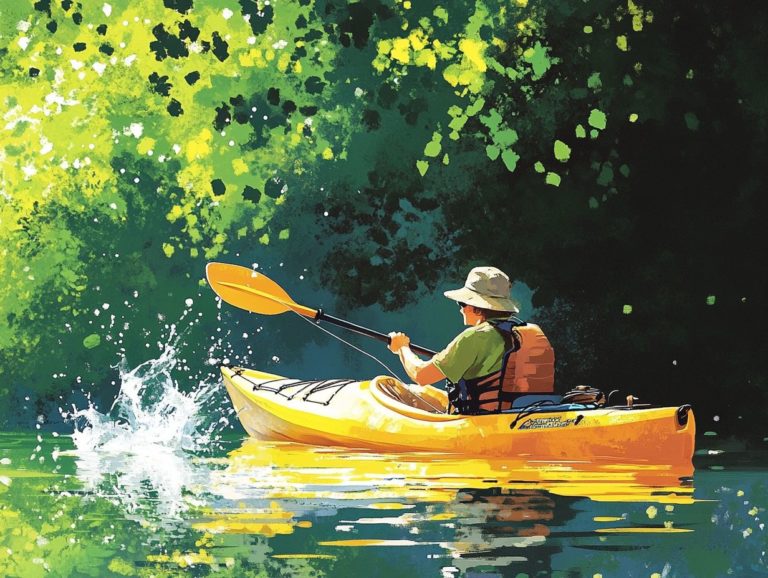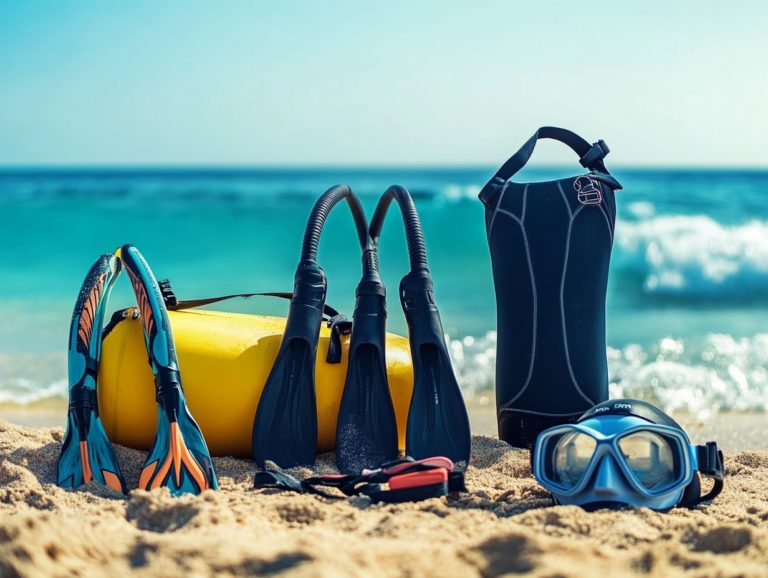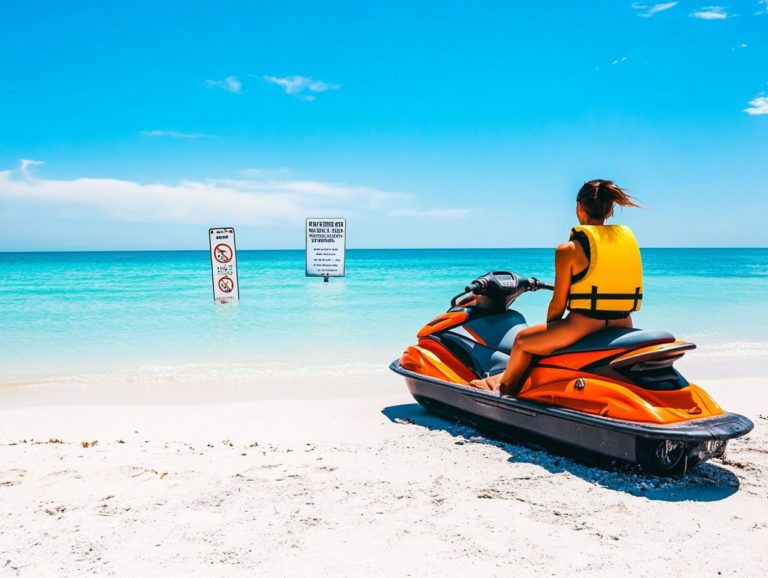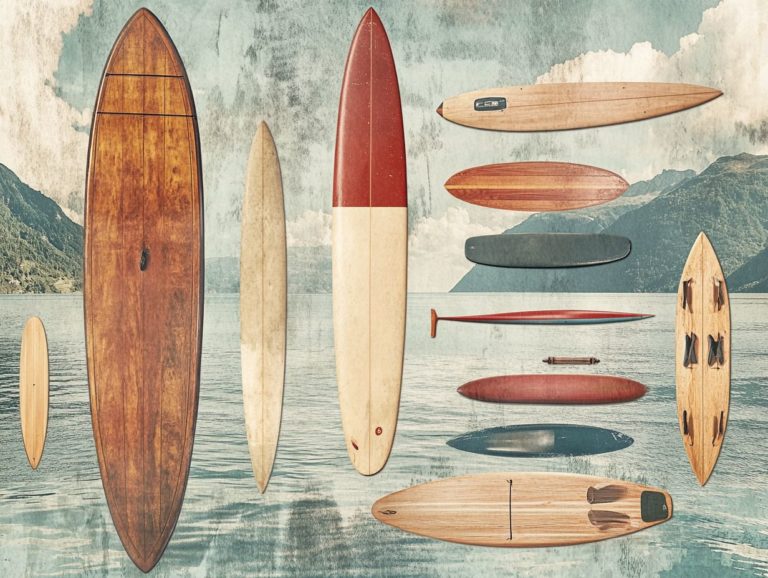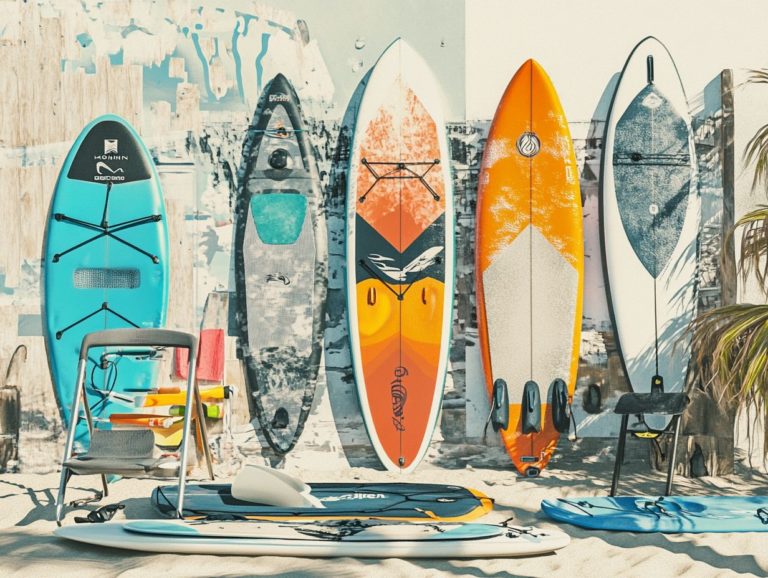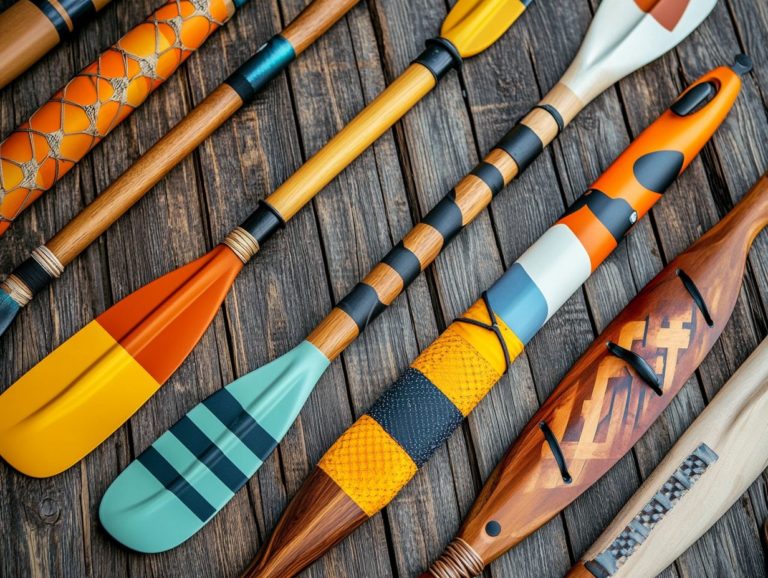Top 10 Essential Items for Windsurfing
Windsurfing presents an exhilarating fusion of surfing and sailing, offering you a distinctive way to revel in the water’s embrace. It provides a thrilling adventure on the waves.
Regardless of whether you’re a seasoned pro or a curious beginner, it’s crucial to have the right equipment for a safe and enjoyable experience.
Here are the top 10 essential items you need to conquer the waves, from your windsurfing board and sail to safety gear like wetsuits and life jackets, as well as important components like the fin.
You will also find key features to consider, including size, materials, and design, along with tips for selecting the best equipment. So get ready to gear up for your next grand adventure on the water!
Contents
- Key Takeaways:
- 1. Windsurfing Board
- 2. Sail
- 3. Mast
- 4. Boom
- 5. Universal Joint
- 6. Harness
- 7. Wetsuit
- 8. Life Jacket
- 9. Helmet
- 10. Booties
- 11. Gloves
- 12. Sunglasses
- 13. Sunscreen
- 14. Repair Kit
- 15. First Aid Kit
- What Are the Different Types of Windsurfing Boards?
- Frequently Asked Questions
- What are the top 10 essential items for windsurfing?
- Do I need to have my own equipment to go windsurfing?
- What size board and sail should I choose for my windsurfing setup?
- Why is a harness necessary for windsurfing?
- Is a wetsuit necessary for windsurfing?
- What should I look for in a windsurfing helmet?
Key Takeaways:
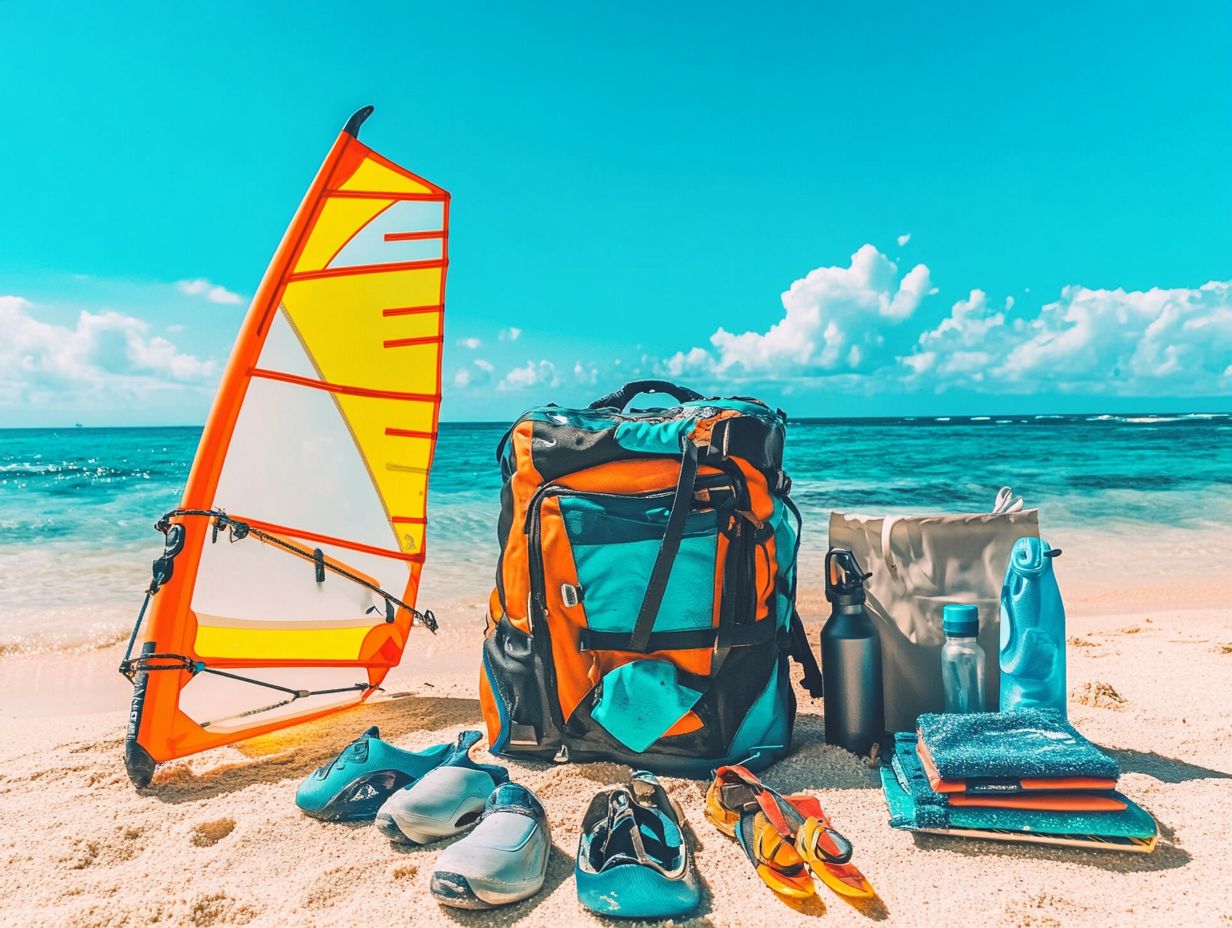
- A windsurfing board is essential for riding the waves.
- The sail is the engine of windsurfing, providing power and speed.
- Properly fitting gear, such as a harness, wetsuit, and life jacket, is crucial for safety and comfort, especially for beginners.
1. Windsurfing Board
The windsurfing board is an essential component for both beginners and seasoned riders. It delivers the stability and control needed to navigate various wind conditions, enhancing your overall performance on the water.
Choosing the perfect size, lightweight materials, and design will make your adventure unforgettable!
As you explore different types of boards available, you ll find options tailored for various conditions, from freeride to wave and freestyle boards. Each category features unique dimensions and shapes that directly impact maneuverability and speed.
Brands like Starboard and JP Australia shine in the market, providing a diverse range of boards suited to different skill levels. If you re just starting out, consider your weight and windsurfing intentions before making a choice, aiming for a board that offers ample volume for stability.
Choosing a wider board often enhances your balance and stability, making it easier to build your confidence on the water.
2. Sail
Windsurfing sails are integral to your overall experience on the water, significantly affecting stability and performance in various wind conditions. Understanding their key features is essential, especially for beginners.
You’ll find a range of sail types on the market, each tailored for specific conditions and skill levels. For example, nylon sails are popular due to their durability and affordability. In contrast, carbon sails deliver exceptional performance and responsiveness, though they come at a premium price.
When selecting a sail, consider crucial factors such as size measured in square meters and the sail’s wind range. These elements directly influence maneuverability and speed. As a beginner, consider choosing slightly larger sails that provide added stability.
By diving into these aspects, you can choose sails that truly meet your needs and preferences, elevating your windsurfing adventures to new heights.
3. Mast
Choosing the right mast is vital in windsurfing because it directly affects the sail’s performance, stability, and overall setup making it an essential element for both beginners and experienced riders.
Masts come in various types, each tailored to specific sailing styles and conditions. For example, carbon masts are often preferred due to their lightweight nature, providing enhanced responsiveness and speed on the water.
When it s time to select a mast, consider the sail type and your weight. A taller mast might work wonders for larger sails, while a shorter one could be just what you need for smaller sizes, ensuring proper setup and performance.
Don t overlook proper mast setup, either. It s crucial for ensuring optimal performance and balancing forces correctly, key to achieving that exhilarating windsurfing experience you crave, especially for beginners.
So gear up and hit the waves your adventure awaits!
4. Boom
The boom connects you to the sail. It gives you control and stability, which greatly affects your performance on the water, especially as a beginner.
This connection allows you to adjust the sail’s angle relative to the wind, helping you maximize speed and maneuverability.
The design of the boom influences how it feels in your hands. A softer grip enhances comfort, while a stiffer structure offers improved feedback.
Choosing the right boom for your skill level and specific sailing style be it freestyle, slalom, or wave sailing is crucial.
A well-suited boom not only enhances handling but also boosts your confidence, leading to a more enjoyable experience on the water.
5. Universal Joint
The universal joint connects the mast and boom. It provides the flexibility and stability needed during maneuvers.
This important component helps you manage the sail’s angle easily, adapting to sudden wind shifts.
For those eager to refine their skills, a reliable universal joint makes a difference in navigating varying gusts smoothly.
When selecting a joint, consider your skill level. Beginners often find that a robust, forgiving design suits them best.
Don t underestimate the importance of regular maintenance. Checking for wear and ensuring proper lubrication extends the life and enhances the performance of your universal joint.
6. Harness
A windsurfing harness is critical for support. It helps you steer better and reduces fatigue on long sessions.
You can choose between seat harnesses, which provide excellent lower back support, and waist harnesses, which allow for more freedom of movement.
The harness you select directly impacts your ability to steer and balance on the board, leading to a safer and more enjoyable experience.
Learning to wear the harness correctly is essential. It should fit snugly, allowing for comfortable movement.
When securing the lines, ensure they re evenly tensioned. This helps maintain proper positioning and leverage during maneuvers.
With the right harness setup, windsurfing enthusiasts can significantly elevate their performance.
7. Wetsuit
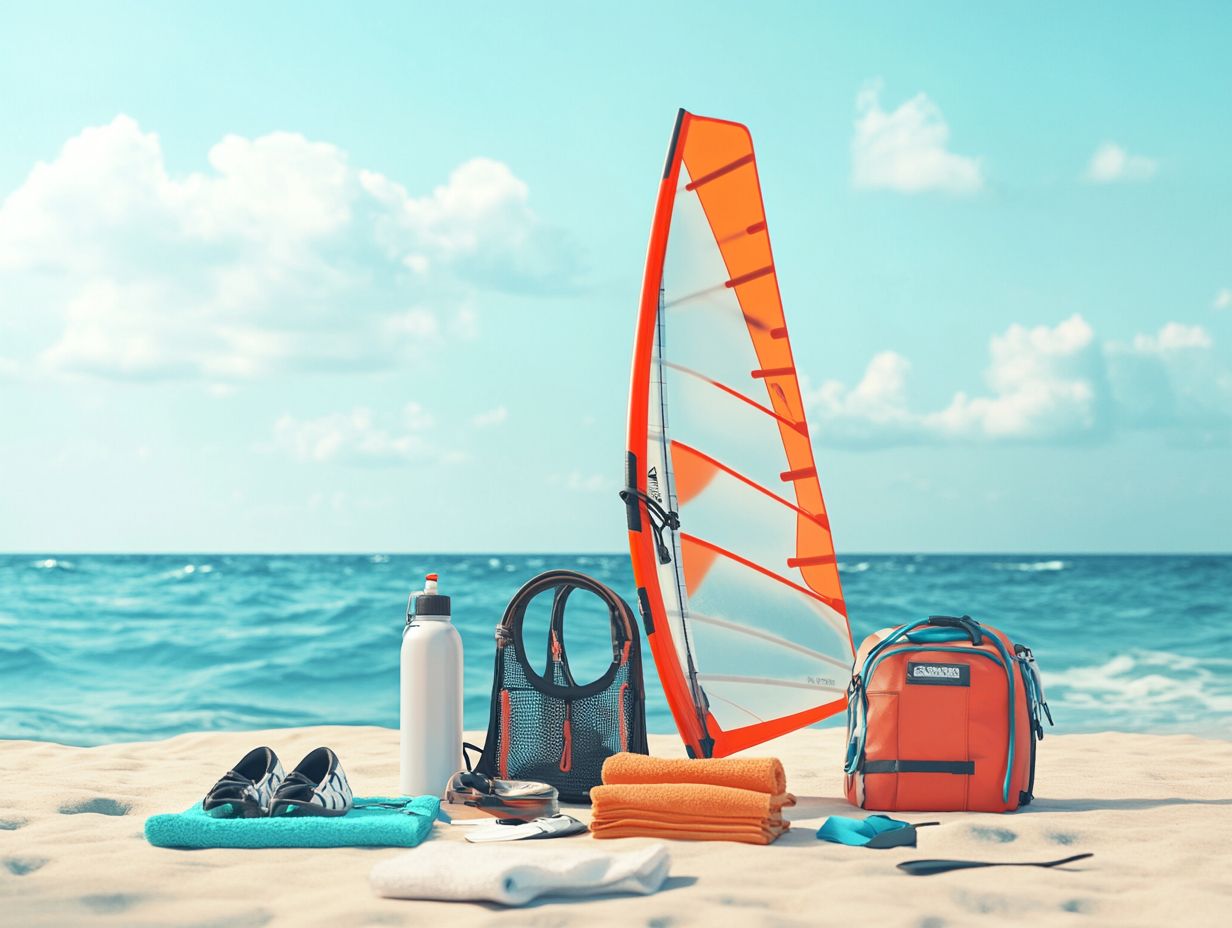
A quality wetsuit is essential for safety. It keeps you warm and protected from the elements.
Wetsuits come in various materials and thicknesses, from thin, flexible models for warmer conditions to thicker options for exceptional warmth in cold temperatures.
Typically crafted from neoprene, a type of rubber, these suits deliver different insulation levels, ensuring you stay comfortable.
When selecting a wetsuit, consider factors such as water temperature, personal fit, and the type of activities you plan to engage in.
This helps you find the perfect balance between warmth and flexibility, ensuring safety and enjoyment during every windsurfing adventure.
8. Life Jacket
Wearing a life jacket is a must for windsurfers, especially if you’re just starting out. It guarantees buoyancy and lets you focus on enjoying the ride, no matter what the water throws at you.
When choosing the right life jacket, prioritize comfort and mobility. You need freedom of movement to perform maneuvers with confidence. Look for a personal flotation device designed specifically for windsurfing; it should allow a full range of arm motion without compromising your experience.
As a beginner, keep an eye out for jackets that feature essential components like:
- Adjustable straps for a snug fit
- Lightweight materials for easy wear
- A design that maintains your balance on the board, ensuring stability during maneuvers.
Don t forget about visibility bright colors can make a big difference, especially in crowded waters. Gear up smartly and dive into the thrill of windsurfing!
9. Helmet
A helmet is essential safety gear in windsurfing, particularly for beginners. It offers vital protection against potential head injuries during falls or accidents on the water.
As you begin your journey or refine your skills, understanding the different types of helmets can enhance your experience. There are several designs specifically crafted for windsurfing, ranging from lightweight options made from a type of foam for added durability and performance that provide basic protection to full-shell helmets, offering comprehensive coverage during intense maneuvers.
Look for key features like proper ventilation for comfort during longer sessions, a secure fit to prevent shifting during maneuvers, and padding designed to absorb impact effectively while ensuring a comfortable fit. When choosing your helmet, consider the riding conditions rough waters may require a more robust model to handle increased wind speed and water conditions, while calm settings might allow for a sleeker version.
Remember, the right helmet boosts your safety and enhances the overall enjoyment of the sport, especially for beginners learning the nuances of control.
10. Booties
Windsurfing booties are essential for protecting your feet while providing grip and comfort through various materials like synthetic fabric on the board. This is especially crucial for beginners navigating different water conditions.
These accessories safeguard against sharp objects and enhance performance during outdoor activities and harsh temperatures. They also improve your overall stability on the board, particularly as you get used to different designs and setups. You ll find a wide range of styles available from lightweight summer versions that are easy to handle in warm waters to thicker, insulated options designed for cooler climates.
The ideal pair often depends on the specific water conditions you encounter, like temperature and the presence of rocks or coral.
Your preferences, including color and fit, are key factors in making your final selection. After all, comfort directly influences your confidence and enjoyment while windsurfing.
11. Gloves
Don t hit the water without your windsurfing gloves! Available in various styles, these gloves often slip under the radar, but they can significantly elevate your grip and comfort, enhancing your performance, especially if you’re just starting out.
Windsurfing gloves come in various materials, all crafted to endure the elements while ensuring you maintain a secure hold on the sail and boom. Common materials include neoprene, which provides warmth without bulk, and synthetic leather, known for its durability and superior grip.
When selecting gloves, consider your fit and dexterity preferences, as well as the weather conditions you ll face. If you re hitting the waves in warmer climates, lighter gloves with ventilation for sunny days when sunblock is also necessary might be the perfect choice. Conversely, if you re braving colder waters, thicker, insulated options will serve you better. Taking these factors into account can profoundly enhance your windsurfing experience.
12. Sunglasses
Windsurfing sunglasses are essential for safeguarding your eyes from harmful UV rays and glare while enhancing your visibility on the water. They are a vital component of your safety gear for any outdoor adventure.
Selecting the right pair can affect your performance and comfort as you glide across the waves. Look for features like UV protection to shield your eyes from the sun s damaging rays and polarized lenses to reduce glare from the water.
Brands like Oakley and Maui Jim excel in crafting high-quality sunglasses tailored for water sports, offering designs for various weather conditions. On overcast days, lighter lenses might do the trick, while mirrored lenses are perfect for sun-drenched outings, ensuring you enjoy optimal visibility for every thrilling windsurfing experience.
13. Sunscreen
Sunscreen is a must-have for windsurfers, providing vital protection against harmful UV rays during those extended outdoor sessions, particularly for beginners on the water.
Choosing the right sunscreen can greatly influence your skin health, especially since water’s reflective qualities can amplify UV exposure. It’s crucial to select products with a high SPF rating, ideally 30 or above. Opt for water-resistant formulas to ensure you stay protected, even when splashes or sweat come into play.
When applying sunscreen, don t hold back; generous amounts should cover all exposed areas. Remember to reapply every two hours, especially after swimming or drying off. Consider using broad-spectrum formulations that shield against both UVA and UVB rays for comprehensive protection.
14. Repair Kit
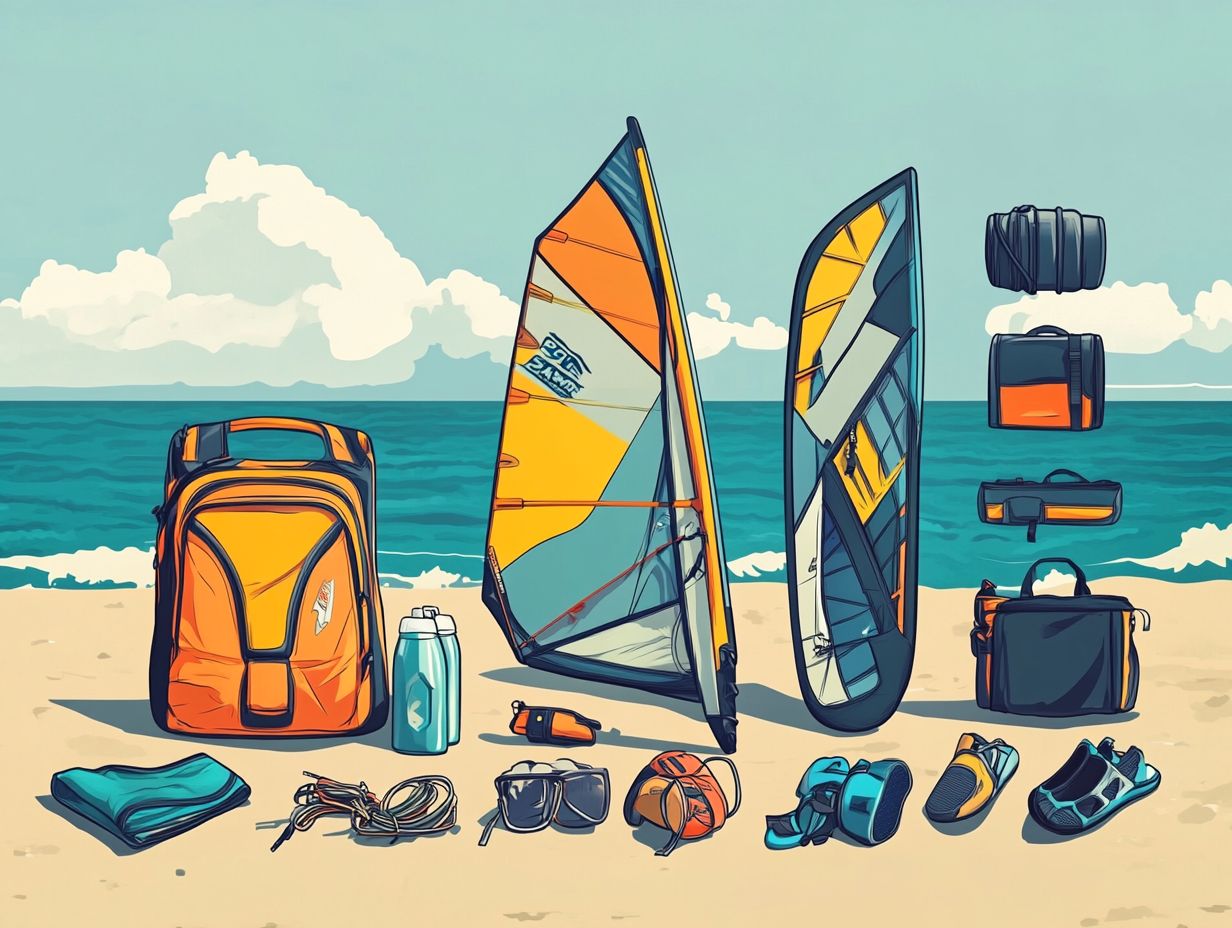
Having a repair kit at your fingertips is vital for any windsurfer, especially those who are just getting started in the sport. It enables you to make quick fixes to equipment damage, ensuring that your safety and enjoyment on the water remain uninterrupted.
This level of preparation minimizes downtime and grants you the peace of mind to fully immerse yourself in the exhilarating experience of riding the waves. Here’s what you need in your repair kit:
- Duct tape
- A patch kit
- Scissors
- A multi-tool
- A pump adapter
Duct tape is your go-to for versatile, temporary fixes on sails or boards, while a patch kit effectively seals up small tears. The multi-tool becomes invaluable for tightening screws or making necessary adjustments, and a pump adapter allows you to swiftly handle any air pressure changes. For a complete list, check out the top 10 must-have items for sailing.
Regular maintenance checks and having a reliable repair kit on hand are equally important. They help you identify potential issues before they escalate, ensuring that every session remains thrilling and worry-free.
Prepare your gear, stay safe, and enjoy the thrill of windsurfing!
15. First Aid Kit
A well-stocked first aid kit is an absolute essential for you as a windsurfer. It offers crucial supplies to treat minor injuries and ensure your safety during outdoor escapades.
Whether it s a s scraped knee from an unexpected tumble or a nasty sunburn from too much fun under the sun, having the right supplies readily available can make a world of difference. Your kit should include essential items such as a fin, boom, and straps to keep your gear in top shape.
- Adhesive bandages in various sizes
- Antiseptic wipes for cleaning cuts
- Gauze for larger wounds
It s wise to toss in a cold pack for sprains and muscle strains. Don t forget sunscreen; it is essential for preventing painful sunburns. A little pain relief medications can go a long way in managing discomfort after an exhilarating session.
Being prepared enhances your safety and lets you enjoy your windsurfing adventures fully without worrying about the pros and cons of different gear, including the top 10 water sports equipment for beginners.
What Are the Different Types of Windsurfing Boards?
Windsurfing boards come in a variety of types, each crafted to cater to specific riding styles and conditions. Understanding the differences in size, weight, and dimensions of boards is key to improving your performance and stability on the water.
Choosing the right board improves your learning curve and keeps you safe. There are primarily three categories of windsurfing boards:
- Freestyle boards: Typically shorter, these boards allow for easy maneuverability and tricks, making them perfect for those eager to showcase flashy moves.
- Slalom boards: Longer and narrower, these are designed for speed and upwind performance, ideal if you re looking to race or travel long distances.
- Wave boards: With their directional shape, these excel in rough waters, catering to more experienced surfers who crave thrilling conditions.
For beginners, starting with a freestyle or an all-around board is wise; these offer greater stability and versatility, paving the way for a smooth entry into the sport.
What Are the Key Features to Look for in a Windsurfing Sail?
When selecting a windsurfing sail, focus on features that affect performance. Consider factors like the sail s area, which directly affects both power and control. This ensures an enjoyable experience for every adventure.
The sail s aspect ratio refers to how the sail’s width compares to its height, impacting speed and maneuverability. The sail s material is another crucial aspect, impacting durability and weight. You can pick from materials like monofilm, which is lightweight, or dacron, which is sturdy.
Don t overlook the sail s profile and shape; these are critical for achieving peak performance. These elements dictate how the sail interacts with the wind. For practical advice, seek out local experts or join a windsurfing community. They can provide invaluable guidance on selecting the right size for your skill level and the conditions you’ll be facing.
How Do You Choose the Right Size Mast for Your Windsurfing Sail?
Selecting the right mast size for your windsurfing sail is crucial for achieving peak performance and enjoying the fun of windsurfing. Get the right mast size now for better control!
To determine the ideal mast size, consider the sail’s specifications like the recommended mast length and its flex characteristics as well as your own weight, which plays a significant role in how the sail handles in various wind conditions. If you’re on the heavier side, a stiffer mast could provide the control and responsiveness you need. Conversely, if you re lighter, a more flexible mast enhances your maneuverability.
Ultimately, the size of the mast will directly influence your windsurfing experience, impacting stability, speed, and that all-important connection you feel with the water. Getting it right can turn a frustrating session into an exhilarating adventure.
What Is the Purpose and Function of a Boom in Windsurfing?
The boom in windsurfing serves a critical role as the connector between the sail and rider. It stabilizes your control and enhances your performance across various wind conditions.
Beyond being a simple connector, the boom is vital for shaping the sail itself. It allows you to adjust the angle and curvature based on wind intensity. This flexibility is especially important for beginners who may find it challenging to determine the best sail position.
By adjusting the boom height and angle, you can significantly improve your stability on the board. Mastering boom control leads to better upwind performance and a more enjoyable time on the water. Understanding these mechanics equips you with the confidence to develop your skills and progress in the sport.
How Do You Properly Wear and Use a Harness in Windsurfing?
Learning to wear and use a harness properly in windsurfing is essential for your comfort and performance. This is especially true as you navigate the details of the sport.
A well-fitted harness can reduce fatigue while maximizing control over the sail, making your time on the water much more enjoyable. Ensure that the harness fits snugly around your waist, with the spreader bar evenly positioned across your hips. Take time to adjust the straps to avoid pinching or discomfort.
Before hitting the water, practice leaning back in the harness while holding the boom. This helps distribute your body weight effectively, reducing strain on your arms and enhancing stability and maneuverability.
Using your harness correctly can significantly improve your riding efficiency. It allows you to harness the wind more effectively while maintaining a relaxed stance.
Frequently Asked Questions
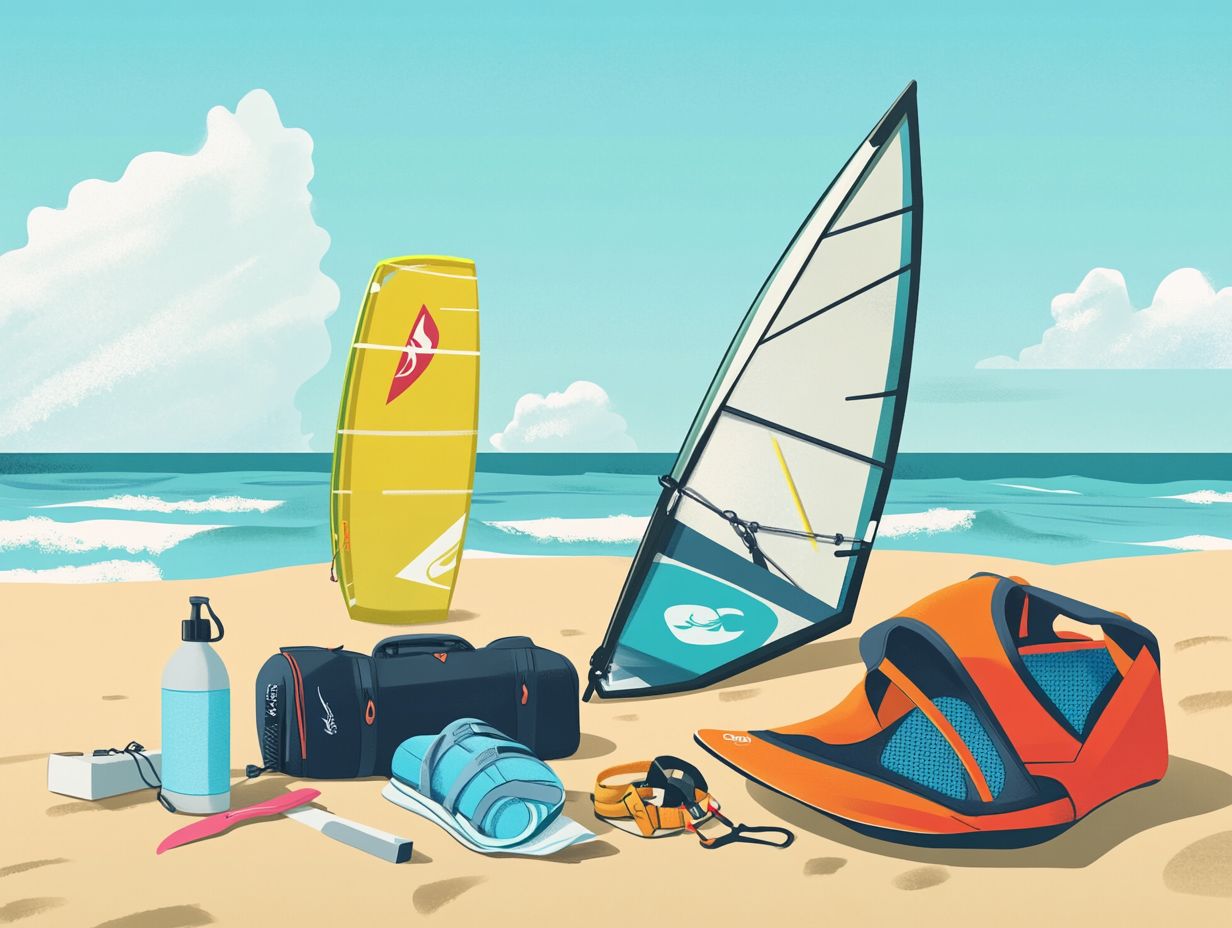
What are the top 10 essential items for windsurfing?
- Board
- Sail
- Mast
- Boom
- Mast base
- Harness
- Wetsuit
- Water shoes
- Life jacket
- Windsurfing helmet
These items are all critical for your performance in varying wind conditions.
Do I need to have my own equipment to go windsurfing?
Yes, having your own equipment for windsurfing is recommended. This allows you to choose gear that fits your skill level and personal preferences, ensuring high-quality materials for durability.
What size board and sail should I choose for my windsurfing setup?
The size of your board and sail depends on your weight, skill level, and wind conditions. It’s best to consult a windsurfing professional to determine the appropriate sizes for your setup, taking into account different brands and dimensions.
Why is a harness necessary for windsurfing?
A harness helps distribute the weight and strain of the sail across your body. This allows for longer sessions with less fatigue, while enabling better control and maneuvering of the board critical for your performance.
Is a wetsuit necessary for windsurfing?
Yes, a wetsuit is essential for windsurfing. It provides insulation and protection from cold water and wind. A wetsuit also offers buoyancy and can prevent injuries from impacts with the board, enhancing your overall safety gear.
What should I look for in a windsurfing helmet?
A windsurfing helmet should fit comfortably and securely, provide good visibility, and be made of durable materials. It should also have ventilation to prevent overheating, making it a vital piece of safety gear.

